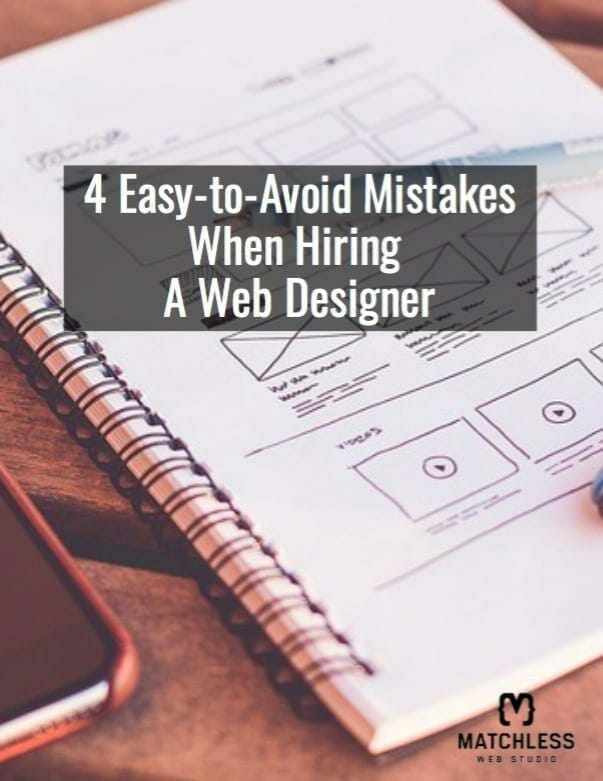Web Design Pricing: The Psychology of Perceived Value

We naturally assume the expensive versions of some things are of higher quality than their less costly counterparts. We all do it. If left unchecked, we can fall into the trap of making purchasing decisions based on how the options available are priced relative to the quality we expect in return for our investment.
Most people expect more value when they spend more money and vice versa.
We’ve all purchased something on Amazon where the product met, exceeded, or under-delivered on the expectations we had for it relative to the price we paid.
Some of us have an unspoken aversion to the cheapest option available – no matter what we’re shopping for. Whether we’ve been burned on cheap purchases before or simply follow some deep-seated, unspoken rule to not buy the lowest-priced option available, it’s generally because we assume that higher prices deliver higher value.
It usually goes that businesses with sizable budgets don’t mind paying more to get what they assume will be better deliverables or results. So they’re happy to fork out the big bucks whether the price is actually justified or not.
Unfortunately, when it comes to web design pricing, paying a lot of money doesn’t guarantee you’ll get high-quality service or deliverables.
How Web Design Pricing Affects Perceived Value

The price someone is willing to pay for any product or service makes two statements.
First, it makes a statement about the buyer. Second, it makes a statement about the estimated value of the product or service in question.
Do you know anyone like this?
They have the very best of things. They don’t skimp on quality. They want their stuff to last a long time without wearing out. They like to make purchases “once and for all” when possible. They spare no expense because they want the best of the best.
Or how about someone like this?
Lower quality isn’t a deal-breaker if the price is right. They don’t mind having to buy something more than once if if it breaks, because it wasn’t expected to last long in the first place. They feel uncomfortable making big purchases – even when they’ve got plenty of money.
Example:
Buying $20 worth of groceries each day of the work week vs. spending $100 in a single grocery trip that will last all week. Because to them, that feels like saving money.
Of course, I’m generalizing here.
There’s a continuum of thoughts and behaviors around buying behavior. But this sums up either end of the extremes.
The point is, when we make purchases, it says something about us AND the product or service. And that’s important to know.
The Psychology of Pricing (Pizza Cutters)

Stay with me here.
If having the best pizza cutter in the world isn’t all that important to you, any ol’ pizza cutter will do. And you’ll buy the pizza cutter that seems well made and reasonably priced when compared to the other contenders.
If you’re only concerned with price and the pizza cutters on the market range on average from $2-15 and $30-50 at the top end, you might have zero reservations buying the $2 option knowing you got the cheapest deal.
But suppose you’re the kind of person who values products made from the best materials available. Bonus points if those products comes with a lifetime guarantee. In that case, you might not hesitate to buy a pizza cutter that is 10x more expensive than all the others on the market.
Why? Because owning THAT pizza cutter and not one of the lesser options on the market means something. It makes a statement about your values and reinforces your identity as someone who buys the very best.
Taken further, imagine two very similar, feature-rich, pizza cutters with a higher-than-most price point. Both are more expensive than nearly all the other products in the market. But one costs $30, and the other is $49. In some buyers’ minds, the more expensive pizza cutter will seem more valuable than the less expensive option. Even if there’s no tangible difference between the two.
Though the less expensive of the priciest options is still more costly than 95% of the other pizza cutters on the market, some people will opt for the most expensive option. Why? Because there’s a level of perceived value baked-in to the higher price. And even if the value is only perceived, it will feel real to a buyer.
And that can influence buying decisions. Some buyers want the best. And if the most expensive option seems like it must be the best, they don’t mind paying more to get it.
Don’t Make Web Design Purchasing Decisions on Price Alone

Extend the pizza cutter example to a business looking to buy web design services. And let’s say the decision-maker(s) is trying to make a hiring decision for a web designer based on two similar proposals.
And let’s say the proposals are incredibly similar in terms of deliverables. But one offers to do the job for $5,200, and the other quotes it for $16,700.
The decision-maker(s) might look at these two proposals with virtually identical deliverables and pick the more expensive option because:
1) money isn’t an issue, and/or
2) it’s assumed to be the “better” option because the higher price implies better deliverables or higher value. The more expensive option must be better. Right??
Plus, if the decision-maker(s) see their company as the type of company that invests in the very best, they may not think twice about spending more than 3 times as much for the more expensive proposal. Because it reinforces a narrative about who they are.
They hire the very best help. They don’t skimp on business investments that will help them get significant returns. They’ll make their money back and then some.
Admittedly, the perceived value in this example could be just that. Perceived. But is the value really going to be there? Or is the highest bidder just taking that business to the bank? That’s the tricky part.
The Web Design Price Trap: Perceived vs. ACTUAL Value

For the person or business making the buying decision, you’re making an investment in your business’ website. So you want the perceived value of any web design proposal to line up with the ACTUAL value that will be delivered.
Don’t fall into the web design price trap.
“Mo’ expensive is not always mo’ better.”
You can quote me on that.
As a general rule, web design agencies are more expensive than freelancers. But an agency’s size doesn’t always correlate with the quality of the work they produce. Nor does the price of their services guarantee quality. And it works in the opposite direction too.
A freelancer or small design shop might charge a great deal less and produce higher quality work. Or they could be cheaper and produce lower quality work. These are all real possibilities.
I’ve redesigned websites that were originally $15k+ agency projects. And I’ve seen some alarming trends.
When I’m hired to redesign or recreate agency-built websites, I sometimes discover:
Unfortunately for the clients…
1) The clients can’t edit anything. They had to pay their previous agency for every single edit.
2) The website’s Google Search performance and traffic is abysmal considering the price they paid their web design agency. Largely because best practice on-page SEO structure is either absent or barely there.
3) The clients are stuck in expensive, on-going contracts with shady terms that make staying with that agency more convenient and affordable than breaking off the deal and looking for help elsewhere.
Don’t Get Taken Advantage of Just Because You Have a Big Budget
It’s a shame when businesses get taken advantage of simply for having a sizable budget.
If you have money to spend and people know it, it’s all too common for agencies and freelancers to jack up their prices without providing the value and deliverables that might justify the price. And that’s wrong.
Some of the most expensive agency sites I’ve rebuilt weren’t worth 1/5 of what the client was originally billed.
I say all this to remind you that an agency having multiple employees and/or big-name clientele is not a stand-in for the results they get or the level of service they deliver.
High prices don’t necessarily equate to value and high-quality deliverables.
You Should Get Your Money’s Worth
I believe in maximizing my clients’ investments.
I give all my clients:
And I don’t lock anyone into shady contracts.
If my client doesn’t want to be a client anymore, It’s cool.
I’m really good at breakups.
In fact, all my contracts come with the “Heaven Forbid it Breakup Plan”.
That means if I ever have end a partnership with a client, the process is way more amicable than ending it with your 7th-grade crush.
One more time for the people in the back
Hiring a big agency DOES NOT guarantee you’ll get high quality deliverables, on-going results, and excellent customer service.

In fact, more often than not, the only thing hiring an agency DOES guarantee is you’ll be paying more for potentially lower-quality deliverables.
If it sounds like I’m being harsh on the industry’s big players, hear me out.
There are phenomenal agencies out there who do incredible work and price their services fairly.
They just might not be any in your local area. So do your due diligence and shop around.
Working with someone local is cool. But don’t be afraid to search for web design service providers across state lines or on the other side of the world. Working with a remote agency or freelancer is super easy these days. It’s 2021 for crying out loud.
When I’m booked up, I like to pass off work to two of my favorite agencies: Monterey Premier (located in California) and Noou (located in the UK). Each does “the agency thing” right and is a dream to work with.
Added Costs When Hiring a Web Design Agency
It’s worth noting that when you pay an agency for web design work, you’re also paying for their project manager’s administrative fees, contributing to that month’s rent and utilities for the physical space they occupy, and payroll for their staff. That’s one of the reasons their prices are what they are.
That’s not to say a freelancer can’t charge you a bundle as well.
Freelance web design can be just as expensive as what you’d pay an agency in some cases.
But when you hire a freelancer, you’re not helping pay a larger business’ overhead. So those chances are slim.
Yes, freelancers have overhead too. But they’re commonly solopreneurs who work from home (like me). So they don’t have to mark up their services to cover the rent on a brick and mortar office space, pay employee salaries and benefits, and cover administrative fees.
Does that mean freelancers don’t mark up their services? By no means! You can simply expect a freelancer’s markup to be exponentially smaller relative to what an agency requires to keep their lights on and make payroll.
The Verdict: Is More Expensive Web Design Better?
I say, “not necessarily”.
Price out the door doesn’t always provide a clear representation of value.
But I believe a more expensive web design service should deliver more value than less expensive services.
A more expensive web designer may be better than a less expensive one. But there’s also a chance you’ll pay more and not get more.
So be a savvy shopper and, again, do your due diligence when pricing your options.
You should expect to get what you pay for your web design project. Within reason.
On some level, the actual value of what’s delivered should be evident. If someone charges $10k+ for a brochure website but can’t explain “why”, I’d be suspicious.
But if they can sell you on the legitimate value, that price may be absolutely justified. Just vet your options and get crystal clear on whether or not the price tag lines up with actual value and deliverables.
4 Easy-to-Avoid Mistakes When
Hiring A Web Designer [PDF]

Businesses grow when they team up with the right people. And they stagnate when they get sucked into bad partnerships.
Hire the right person for your website project the first time. You’ll save time and money. And you’ll spare yourself a lot of frustration in the process.
Get the guide, “4 Easy-to-Avoid Mistakes When Hiring a Web Designer” delivered to your inbox.
[forminator_form id=”507″]
